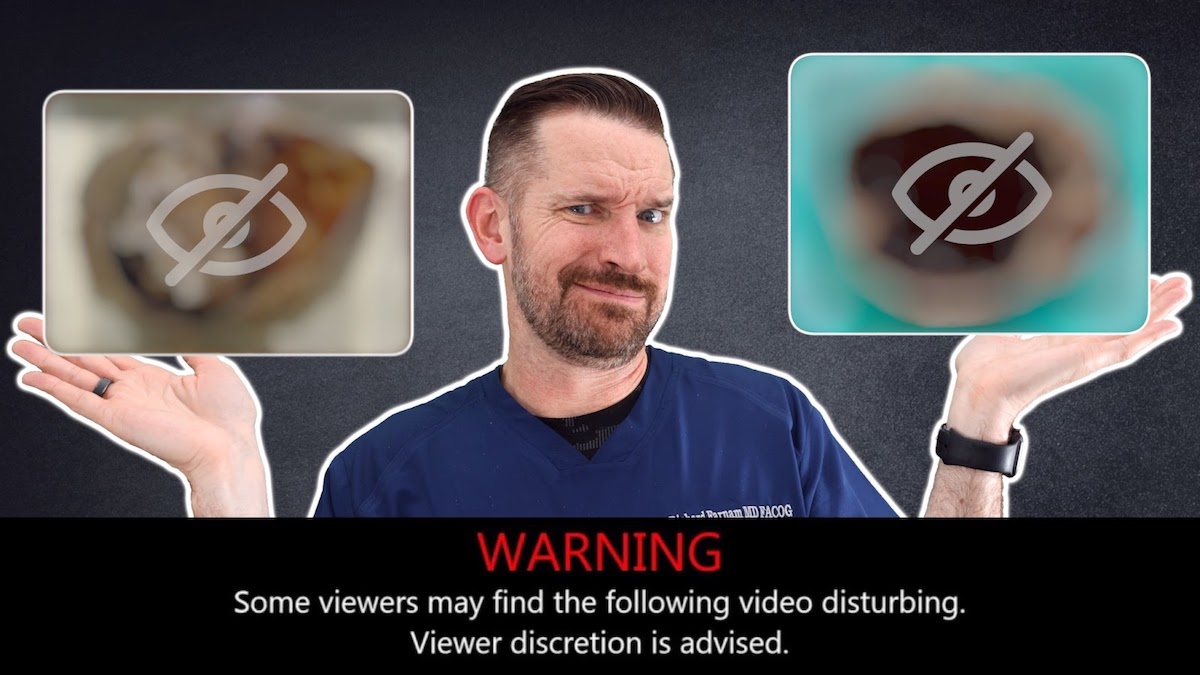Dr. Rich (00:00):
Hi, I’m Dr. Rich. And my passion is to provide every medical provider with up-to-date knowledge about the world of women’s health. Today, we’re going to pick up where we left off with our zoom interview with Dr. Erin Meyers.
Don’t have time to read this blog post? Watch it here instead!
Dr. Rich (00:19):
Some surgeons kind of have a set idea of what they want their mesh to be, how far, and they trim it as such, um, when we were doing, uh, an ox course last year, a fellows course, you had, um, specifically address that rather than just saying, I want six centimeters anteriorly. Um, and I’ll let you describe it. Like we actually want to evaluate what the urethral length and the entire, you know, anterior vaginal wall length is.
Dr. Meyers (00:50):
So, I appreciate that question. And I think each Colpopexy should be individualized for the actual patient. And so I really do think it’s important to do an exam under anesthesia before you go sit at the console and perform the surgery. And part of that is placing the Foley, feeling the length of the urethra and where the fully bowl actually rests. Uh, what that does is it helps me know. I kind of measure in my mind’s eye, the distance from the cervix, or, you know, apex of the vagina to the Foley bulb. Uh, and you know, we’re used to measuring with our fingers, we know cervical dilation, so you can kind of guess, okay, I think that’s going to be four centimeters. That might be six centimeters. And so before you even go sit at the console, you know, what your potential is for the dissection. I’ve been surprised a couple of times, some ladies have a really long urethra, a really high try going. And when I start to dissect, it might be two centimeters. And I’m like, I’m getting into this thick area that looks like try going, but I’m only two, three centimeters in I go perform cysto or, you know, have someone check where’s the Foley bulb and like, Nope, we’re done. Um, and so I think if you pay attention to some of those cues, the patient will tell you exactly what dissection you need to do.
Dr. Rich (02:05):
Great. Um, the other issue that often comes up is that of redundant bowel. So small bowel, um, even seek them and appendix or large bow, uh, what are some of the tricks that you’ve used to kind of take that out of the equation and Uncomplicate the case in that sense?
Dr. Meyers (02:27):
Uh, so I think a couple things, one is if she already has valid Haitians, especially to the left, I leave them there. Cause I think they’re helpful, um, to, uh, you can use an assistant or some devices like a T lift or something else like that. But I think for me, and, and this is going to be individual for every surgeon, but for me in my practice, I’m pretty strict with a BMI cutoff. And I feel like when a patient has a reasonable BMI, she’s much less likely to have small and large bowel interference with the sacrum. It’s going to be a safer, and she’s going to have a lower risk of prolapse recurrence going forward, and she’s going to be a healthier person overall. So I really do feel like this is a quality of life surgery. And I’d say recently, uh, I’ve had more and more patients really excited about the idea of having a referral to maybe bariatric surgery or to weight loss. And we’ll do that first. And when they achieve a safe BMI, then we move forward with a Colpopexy.
Dr. Rich (03:29):
Yeah. And I think that that is a very important concept that, um, it’s not for every single patient, uh, and surgery itself is not for every single patient. Um, and you do need to individualize each case and each element of the surgery within the case. Um, and I don’t know if you use, uh, either suture seen the large bowel to the left, pelvic sidewall, situationally, um, packing the small bowel with a rate tech like you would do if it was open, um, and then using the, uh, Trump bed, which, you know, pairs with the exci robot and you can actually over trend Dillenberg guys, the, uh, for that portion of the surgery that’s required and then just bring them back out. Um, and so you can not have the theater that they’re going to be in too steep of Trendelenburg for the duration of the case.
Dr. Meyers (04:25):
I think those are all great options. Absolutely.
Dr. Rich (04:29):
So a couple other points I’m going to touch on real quick. Um, I think that it helps for the, um, team to, uh, have a vested interest in the procedure that you’re doing and really that’s on the surgeon to bring the cases. Um, the team is not going to rally around you for a 20 minute turnover. If you know, you’re doing one case a year and it’s six and a half hours. So to that end, I think it’s helpful to kind of have team targets, which, um, our time points that I think are goal setting in the sense that we can reach this level. And we’re always going to try to keep improving until we get there. So for, um, our center, uh, we have an epicenter where surgeons will come in and observe, uh, for a seven o’clock start. We need to be out by nine, which, you know, including the entire wheels into wheels out time, that would be, that would leave you only with a case time of 90 minutes and about 40 to 45 minutes on console.
Dr. Rich (05:36):
Um, and in most cases that would include either the hysterectomy and or the sling for the procedure. Um, and that’s not going to be something that, I mean, this has taken me more than a decade to get to that point. That’s not something that, you know, you can start doing the case and arrive at, but I do think that every surgeon needs to have a clock in their head. And if they’re not winning by three and a half hour, like that type of timeframe, um, we need to decide, you know, do we need to move in another direction at that point? And th those are recommendations that I make, uh, for, you know, attendees and, and residents. What’s your take on that?
Dr. Meyers (06:17):
I would agree with what you’re saying. I think that if you’re going to adopt this modality to your practice or offer this procedure for your patients, you need to be all in. And by that, I mean, majority of your practice needs to be prolapse referrals, and you need to be helping ladies with their prolapse. Uh, and granted, you’re not going to start off with crazy fast times to begin with. Uh, but for me, my goal is 30 minutes or less for hysterectomy and 30 minutes or less for Colpopexy. So hysterectomy, Coldwell plexi, I’m off the console and an hour or less. Uh, and so, you know, that gives you a little bit of time for intubation extubation and you have your sling or, or whatever else you have to do during the case. Um, but you know, I don’t know. I think that you need to think about patient safety.
Dr. Meyers (07:04):
How long is she under anesthesia? Is this the best surgery for her, the best option for her, if the procedures, um, you know, extensively long. And that takes us back to what we were talking about. Like start off with just doing a hysterectomy, maybe that takes two hours to start with, uh, and then you work on each point. I time myself on each and every step, uh, so that I judge myself and I think, well, how can I get better? What can I do faster? Uh, and I luckily have the same team all the time, and so we can grow together. And I think that’s key
Dr. Rich (07:34):
And I’ll mention something that is actually kind of intuitive, but if you hadn’t actually thought about it, um, you know, it may be something that sneaks up on you. And that would be for the surgeon that is, you know, high volume surgeon getting into a Sigrid global backseat is that the patient population is a little bit different. So if you’re used to doing hysterectomy is on perimenopausal women, a lot of the sacred population is not going to have the physiologic reserve. And as we know, age alone is an independent risk factor for complications for your gynecologic surgery. So it’s just something to keep in mind, um, with the patient selection. Um, if you’re building up this volume, cause you’re going, you’re not going to start at, you know, nine minute cases, you’re going to start 2, 3, 4 hours and that’s okay. We all have to start easy on yourself and the patient.
Dr. Meyers (08:36):
I completely agree. And I think that’s why it’s nice to start with one procedure, like just do hysterectomy, just do oophorectomy. And when you get good with those times, then add more and add more rather than trying to do it all at once. And I think some of the benefits of minimally invasive surgery is so the patient can go home the same day. And I really do find that two and a half hour really does make them kind of groggy three hours, four hours. Now we’re looking at maybe she needs to spend the night. Um, and so that kind of negates the point of doing a minimally invasive surgery if you’re planning on sending her home the same day. So just thinking about, you know, where you are in your own learning curve and what you’re able to accomplish, and, you know, perhaps, uh, starting off with simply, you know, hysterectomy to start, maybe hysterectomy, uterosacral, ligaments, uh, start off with that and then slowly work up to, to Colpopexy later.
Dr. Rich (09:26):
That’s all fantastic advice. I, um, also get a question, um, oftentimes about the need for permanent suture versus absorbable, um, and then the need for individual, uh, suture fixation points on the anterior posterior vagina, uh, as opposed to running a barbed suture. Um, what, what does that look like in your practice?
Dr. Meyers (09:51):
Uh, so I have to say that my practice has evolved over time when I was in fellowship training, we performed individual permanent sutures for each different fixation point, maybe like four to six on the front and six on the back. And that’s just what we did for everybody. And what I want to think about maybe a little bit in more, the, the broad history of things is that the mesh has improved over time. And historically the mesh was a lot thicker, more bulky, more stiff, and you needed a permanent stitch to fix the mesh to the vagina or else, you know, the body might wall it off. I’ve actually gone back in on some Colpopexy where the mesh was just sitting in the abdomen away from the vagina entirely. Maybe you’ve seen that as well. Um, but it just acts like a foreign body and almost kind of rejects it.
Dr. Meyers (10:39):
So you needed a permanent mesh, uh, excuse me, you needed a permanent stitch, uh, to be able to fix the mesh to the vagina. Well, now we have such thin and lightweight mesh that it does incorporate nicely. The vaginal tissue kind of holds onto that mesh. So you may not need a permanent stitch for the long term. You just need a long acting dissolvable stitch to hold that mesh there long enough for the body to take over. And so I’ve adopted my practice to using a delayed absorbable, Bart, Barb. Uh, so I’ve adopted my practice to using a delayed absorbable barbed suture, and it’s working very nicely for me.
Dr. Rich (11:17):
So another question that comes up frequently is cervical preservation at the time of hysterectomy hall actually versus total laparoscopic hysterectomy and sacred cold Lexi. So the camps are pretty divided. Uh, I’m on team, super cervical. Uh, what’s your take on it.
Dr. Meyers (11:40):
Uh, so I would agree with you completely surgeon preference. Uh, at this time there are a few reasons for, or against, and I think you have to just understand what profile you’re comfortable with. For me, I do perform total hysterectomy. That means removing the cervix, uh, that does open a suture layer to where the mesh is fixed. And some people are very nervous about that. However, looking at my own data, we have very, very low mesh exposure rates with that. And the benefit that we get out of that is a woman will never have to have a pap smear. Again, she’s not going to have residual cyclical bleeding from maybe some endometrium that’s left on the cervix. Um, and potentially it’s going to offer her a better repair. There are some studies do show, a higher rate of prolapse when the serv, uh, excuse me, some studies do show a higher rate of recurrent prolapse when the cervix is left in place. Uh, so for all of those reasons, I tend to take the cervix out, but there’s not really a right answer that, that we can all agree on right now.
Dr. Rich (12:42):
So one of the other things with the robot is compared to laparoscopy. We actually have a fourth arm, so we have the camera, we have the two robotic arms that we’re operating with. And then we have the ability to provide static and, or dynamic retraction with a fourth arm, uh, during the case. And I think all of this is not just recommended, but essential for doing these complicated Sacrocolpopexy type surgeries. Also, um, you know, I, I know some surgeons prefer just to do the manipulation with their fourth arm, but for me, I think that you really want to optimize visualization, optimize all of the points of traction counter traction. And to that end, I would always recommend that the, uh, surgeon use some type of either uterine or vaginal manipulator.
Dr. Meyers (13:34):
I couldn’t agree more. I do think that the fourth arm is essential, so we’re not going to just get rid of it. But I use the fourth arm to retract tissue, sometimes retract the uterus for part of the hysterectomy or retract the large bowel. Uh, and then I’ll use, uh, with the assistance of my surgical team, I’ll have a vaginal manipulator placed and that does help with traction, counter traction I’ll even use. Uh, my assistant will even use a vaginal manipulator, uh, to offer counter traction while I do my sacral dissection. Like I’m not even at the vaginal dissection, but it provides tension to the sacrum that allows the space to open up easier. So I completely agree with you, traction, counter traction, use all the manipulation you have available your first arm, your second arm, your camera, your, your fourth arm and, uh, vaginal manipulation.
Dr. Rich (14:25):
Well, thanks again for coming on. Um, if a surgeon thought that this was helpful and they, uh, would want to reach out and get more information, education training, that kind of thing, how could they get in touch with you?
Dr. Meyers (14:38):
Well, we’ve welcomed to reach out to me through my office, uh, to call the office directly or through my atrium health website.
Dr. Rich (14:45):
Fantastic. All right. Thanks again. If you have questions or comments that we didn’t cover, regarding Sacrocolpopexy, please drop them in the comment section below and as always, please remember to subscribe for more great content for residents, fellows, gynecologists, and your gynecologists.




